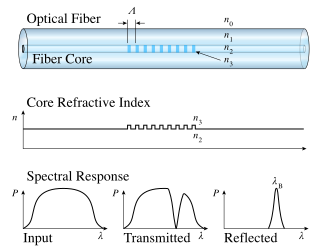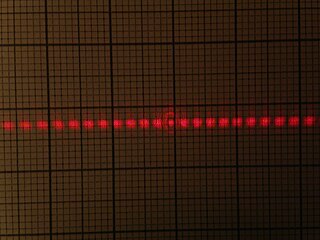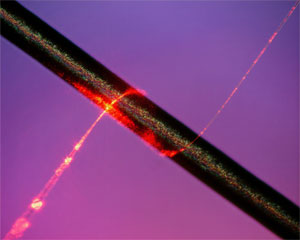Related Research Articles
Refractive index contrast, in an optical waveguide, such as an optical fiber, is a measure of the relative difference in refractive index of the core and cladding. The refractive index contrast, Δ, is often given by , where n1 is the maximum refractive index in the core and n2 is the refractive index of the cladding. The criterion n2 < n1 must be satisfied in order to sustain a guided mode by total internal reflection. Alternative formulations include and . Normal optical fibers, constructed of different glasses, have very low refractive index contrast (Δ<<1) and hence are weakly-guiding. The weak guiding will cause a greater portion of the cross-sectional Electric field profile to reside within the cladding as compared to strongly-guided waveguides. Integrated optics can make use of higher core index to obtain Δ>1 allowing light to be efficiently guided around corners on the micro-scale, where popular high-Δ material platform is silicon-on-insulator. High-Δ allows sub-wavelength core dimensions and so greater control over the size of the evanescent tails. The most efficient low-loss optical fibers require low Δ to minimise losses to light scattered outwards.

A laser diode is a semiconductor device similar to a light-emitting diode in which a diode pumped directly with electrical current can create lasing conditions at the diode's junction.
Optics is the branch of physics which involves the behavior and properties of light, including its interactions with matter and the construction of instruments that use or detect it. Optics usually describes the behavior of visible, ultraviolet, and infrared light. Because light is an electromagnetic wave, other forms of electromagnetic radiation such as X-rays, microwaves, and radio waves exhibit similar properties.

A photonic crystal is an optical nanostructure in which the refractive index changes periodically. This affects the propagation of light in the same way that the structure of natural crystals gives rise to X-ray diffraction and that the atomic lattices of semiconductors affect their conductivity of electrons. Photonic crystals occur in nature in the form of structural coloration and animal reflectors, and, as artificially produced, promise to be useful in a range of applications.

Photonic-crystal fiber (PCF) is a class of optical fiber based on the properties of photonic crystals. It was first explored in 1996 at University of Bath, UK. Because of its ability to confine light in hollow cores or with confinement characteristics not possible in conventional optical fiber, PCF is now finding applications in fiber-optic communications, fiber lasers, nonlinear devices, high-power transmission, highly sensitive gas sensors, and other areas. More specific categories of PCF include photonic-bandgap fiber, holey fiber, hole-assisted fiber, and Bragg fiber. Photonic crystal fibers may be considered a subgroup of a more general class of microstructured optical fibers, where light is guided by structural modifications, and not only by refractive index differences.
In optics, an anti-resonant reflecting optical waveguide (ARROW) is a waveguide that uses the principle of thin-film interference to guide light with low loss. It is formed from an anti-resonant Fabry–Pérot reflector. The optical mode is leaky, but relatively low-loss propagation can be achieved by making the Fabry–Pérot reflector of sufficiently high quality or small size.
Polaritonics is an intermediate regime between photonics and sub-microwave electronics. In this regime, signals are carried by an admixture of electromagnetic and lattice vibrational waves known as phonon-polaritons, rather than currents or photons. Since phonon-polaritons propagate with frequencies in the range of hundreds of gigahertz to several terahertz, polaritonics bridges the gap between electronics and photonics. A compelling motivation for polaritonics is the demand for high speed signal processing and linear and nonlinear terahertz spectroscopy. Polaritonics has distinct advantages over electronics, photonics, and traditional terahertz spectroscopy in that it offers the potential for a fully integrated platform that supports terahertz wave generation, guidance, manipulation, and readout in a single patterned material.

A fiber Bragg grating (FBG) is a type of distributed Bragg reflector constructed in a short segment of optical fiber that reflects particular wavelengths of light and transmits all others. This is achieved by creating a periodic variation in the refractive index of the fiber core, which generates a wavelength-specific dielectric mirror. Hence a fiber Bragg grating can be used as an inline optical fiber to block certain wavelengths or it can be used as wavelength-specific reflector.

A distributed Bragg reflector (DBR) is a reflector used in waveguides, such as optical fibers. It is a structure formed from multiple layers of alternating materials with varying refractive index, or by periodic variation of some characteristic of a dielectric waveguide, resulting in periodic variation in the effective refractive index in the guide. Each layer boundary causes a partial reflection of an optical wave. For waves whose vacuum wavelength is close to four times the optical thickness of the layers, the many reflections combine with constructive interference, and the layers act as a high-quality reflector. The range of wavelengths that are reflected is called the photonic stopband. Within this range of wavelengths, light is "forbidden" to propagate in the structure.

An optical fiber is a flexible, transparent fiber made by drawing glass (silica) or plastic to a diameter slightly thicker than that of a human hair. Optical fibers are used most often as a means to transmit light between the two ends of the fiber and find wide usage in fiber-optic communications, where they permit transmission over longer distances and at higher bandwidths than electrical cables. Fibers are used instead of metal wires because signals travel along them with less loss; in addition, fibers are immune to electromagnetic interference, a problem from which metal wires suffer. Fibers are also used for illumination and imaging, and are often wrapped in bundles so they may be used to carry light into, or images out of confined spaces, as in the case of a fiberscope. Specially designed fibers are also used for a variety of other applications, some of them being fiber optic sensors and fiber lasers.
An optical waveguide is a physical structure that guides electromagnetic waves in the optical spectrum. Common types of optical waveguides include optical fiber and transparent dielectric waveguides made of plastic and glass.

Double-clad fiber (DCF) is a class of optical fiber with a structure consisting of three layers of optical material instead of the usual two. The inner-most layer is called the core. It is surrounded by the inner cladding, which is surrounded by the outer cladding. The three layers are made of materials with different refractive indices.

Extraordinary optical transmission (EOT) is the phenomenon of greatly enhanced transmission of light through a subwavelength aperture in an otherwise opaque metallic film which has been patterned with a regularly repeating periodic structure. Generally when light of a certain wavelength falls on a subwavelength aperture, it is diffracted isotropically in all directions evenly, with minimal far-field transmission. This is the understanding from classical aperture theory as described by Bethe. In EOT however, the regularly repeating structure enables much higher transmission efficiency to occur, up to several orders of magnitude greater than that predicted by classical aperture theory. It was first described in 1998.
Silicon photonics is the study and application of photonic systems which use silicon as an optical medium. The silicon is usually patterned with sub-micrometre precision, into microphotonic components. These operate in the infrared, most commonly at the 1.55 micrometre wavelength used by most fiber optic telecommunication systems. The silicon typically lies on top of a layer of silica in what is known as silicon on insulator (SOI).

Digital planar holography (DPH) is a method for designing and fabricating miniature components for integrated optics. It was invented by Vladimir Yankov and first published in 2003. The essence of the DPH technology is embedding computer designed digital holograms inside a planar waveguide. Light propagates through the plane of the hologram instead of perpendicularly, allowing for a long interaction path. Benefits of a long interaction path have long been used by volume or thick holograms. Planar configuration of the hologram provider for easier access to the embedded diagram aiding in its manufacture.

A slot-waveguide is an optical waveguide that guides strongly confined light in a subwavelength-scale low refractive index region by total internal reflection.

A subwavelength-diameter optical fibre is an optical fibre whose diameter is less than the wavelength of the light being propagated through it. An SDF usually consists of long thick parts at both ends, transition regions (tapers) where the fibre diameter gradually decreases down to the subwavelength value, and a subwavelength-diameter waist, which is the main acting part. Due to such a strong geometrical confinement, the guided electromagnetic field in an SDF is restricted to a single mode called fundamental.

A hybrid plasmonic waveguide is an optical waveguide that achieves strong light confinement by coupling the light guided by a dielectric waveguide and a plasmonic waveguide. It is formed by separating a medium of high refractive index from a metal surface by a small gap.

Prof. Ravindra Kumar Sinha is the Vice Chancellor of Gautam Buddha University, Greater Noida, Gautam Budh Nagar Under UP Government. He was the director of the CSIR-Central Scientific Instruments Organisation (CSIR-CSIO) Sector-30C, Chandigarh-160 030, India. He has been a Professor - Applied Physics, Dean-Academic [UG] & Chief Coordinator: TIFAC-Center of Relevance and Excellence in Fiber Optics and Optical Communication, Mission REACH Program, Technology Vision-2020, Govt. of India Delhi Technological University Bawana Road, Delhi-110042, India.
Natalia M. Litchinitser is an Electrical Engineer and Professor at Duke University. She works on optical metamaterials and their application in photonic devices. Litchinitser is a Fellow of the American Physical Society, The Optical Society and the Institute of Electrical and Electronics Engineers.
References
- ↑ Martelli, C; Canning, J; Gibson, B; Huntington, S (2007). "Bend loss in structured optical fibres". Optics Express. 15 (26): 17639–44. Bibcode:2007OExpr..1517639M. doi: 10.1364/OE.15.017639 . PMID 19551059.
- ↑ Canning, J (2002). "Diffraction-free mode generation and propagation in optical waveguides" (PDF). Optics Communications. 207: 35–39. Bibcode:2002OptCo.207...35C. doi:10.1016/S0030-4018(02)01418-9.[ permanent dead link ]
- ↑ Canning, J; Buckley, E; Lyytikainen, K (2003). "Propagation in air by field superposition of scattered light within a Fresnel fiber". Optics Letters. 28 (4): 230–2. Bibcode:2003OptL...28..230C. doi:10.1364/OL.28.000230. PMID 12661527.
- ↑ Huntington, S; Katsifolis, J; Gibson, B; Canning, J; Lyytikainen, K; Zagari, J; Cahill, L; Love, J (2003). "Retaining and characterising nano-structure within tapered air-silica structured optical fibers" (PDF). Optics Express. 11 (2): 98–104. Bibcode:2003OExpr..11...98H. doi: 10.1364/OE.11.000098 . PMID 19461711. Archived from the original (PDF) on 2020-02-10.
- ↑ .J. DiGiovanni, R.S. Windeler, "Article comprising an air-clad optical fiber", U.S. Patent 5,907,652 ; G02B 006/20 (1998 filed 1997); based on previous patent: E.A.J. Marcatili, "Air clad optical fiber waveguide," U.S. Patent 3,712,705 (1973)
- ↑ Åslund, Mattias L.; Canning, John (2009). "Air-clad fibres for astronomical instrumentation: focal-ratio degradation". Experimental Astronomy. 24: 1–7. Bibcode:2009ExA....24....1A. doi:10.1007/s10686-008-9132-7.
- ↑ J. Canning, Fresnel Optics Inside Optical Fibres, in Photonics Research Developments, Chapter 5, Nova Science Publishers, United States, (2008) and refs therein